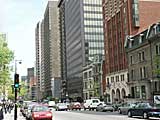7.4
Reinforce or improve the character of some key roadways in the Centre
The Centre is accessed via a limited number of roadways that play a major role in how Montréal is perceived. These roadways offer striking views of Montréal's major features - the river, the skyline, Mount Royal - which are revealed gradually, as one approaches.
The design of streets and boulevards in the Centre, particularly through tree planting and the construction of wide sidewalks, can increase people's sense of comfort.
These must be harmonized with the character of local activities and environments and offer pleasant and accessible rest areas that give people the opportunity to momentarily escape the bustle of the Centre's activity.
These streets must also offer pedestrians and cyclists routes that are direct, safe and pleasant. While many of the Centre's activity nodes are quite close to one another, they remain relatively isolated due to the lack of such links.
Vibrant streets
Vibrant streets offer pedestrians a comfortable, pleasant and stimulating experience, as they are given the most important place on the street. These characteristics are, more concretely, the result of conditions that vary from one street to another in terms of street animation, number of pedestrians, street design, traffic conditions, etc.
Vibrant streets draw much of their appeal from the liveliness produced by retail businesses. Sometimes this attractiveness also results from the way buildings frame the street; the grand sweep of heritage buildings that form an architectural unit on the northern side of De La Commune offers a good example.
The Ville de Montréal intends to preserve and accentuate those qualities that draw pedestrians to vibrant streets. All of the Centre's commercial streets, shown in Illustration 2.3.2, come under this category. The City will prioritize intervention on these streets to increase their conviviality for pedestrians and further improve the way that buildings frame them.
Saint-Laurent
 The dividing line between east and west end Montréal since 1792, Saint-Laurent was a commercial street that gradually became home to entertainment and cultural production facilities. A point of entry for successive waves of immigrants, Saint-Laurent typifies Montréal's cosmopolitanism like no other place in the City. Its heterogeneous morphology and varied environments are an integral part of its lively ambiance, which makes for an urban experience appreciated by Montrealers and tourists alike.
The dividing line between east and west end Montréal since 1792, Saint-Laurent was a commercial street that gradually became home to entertainment and cultural production facilities. A point of entry for successive waves of immigrants, Saint-Laurent typifies Montréal's cosmopolitanism like no other place in the City. Its heterogeneous morphology and varied environments are an integral part of its lively ambiance, which makes for an urban experience appreciated by Montrealers and tourists alike.
In 1996, the historical and cultural importance of Saint-Laurent was affirmed when it was designated a national historic site by the Historic Sites and Monuments Board of Canada.
Strategic links to be improved
The strategic links to be improved serve as connections between significant places, like the Mountain and the river. Their routes are generally punctuated by the presence of other important points of interest and often cross through areas which will soon undergo significant transformation. The southern part of Peel, for example, crosses the institutional node that surrounds the École de technologie supérieure (ETS) and Griffintown, whose vocation is in the midst of being transformed.
Each of these streets has a particular character along its various segments. Therefore, their improvement must employ approaches that are appropriate to each of their components. Through these variations, each street can be made a coherent and interesting thoroughfare, particularly for pedestrians.